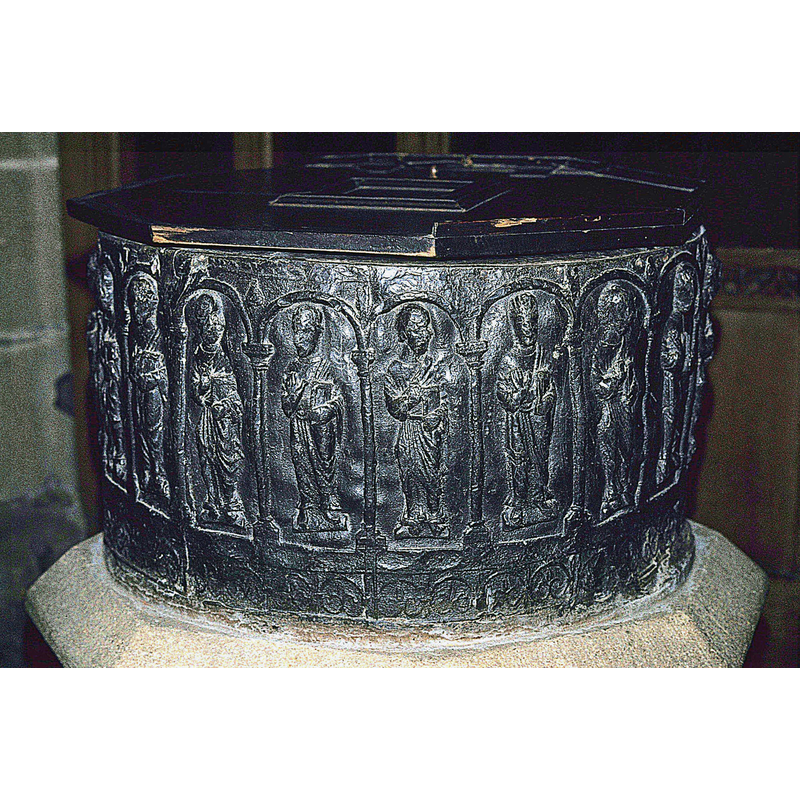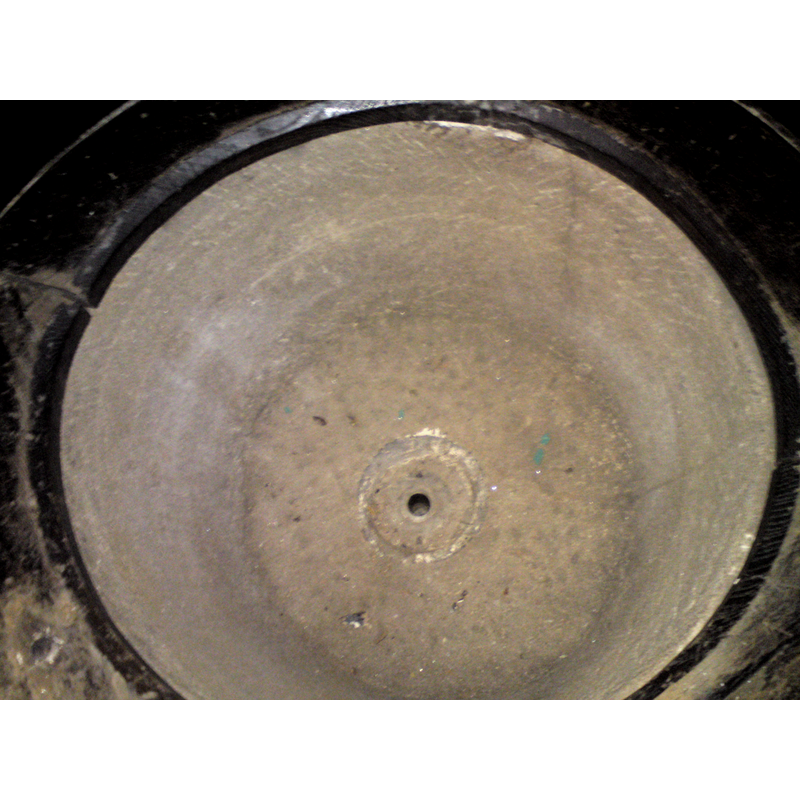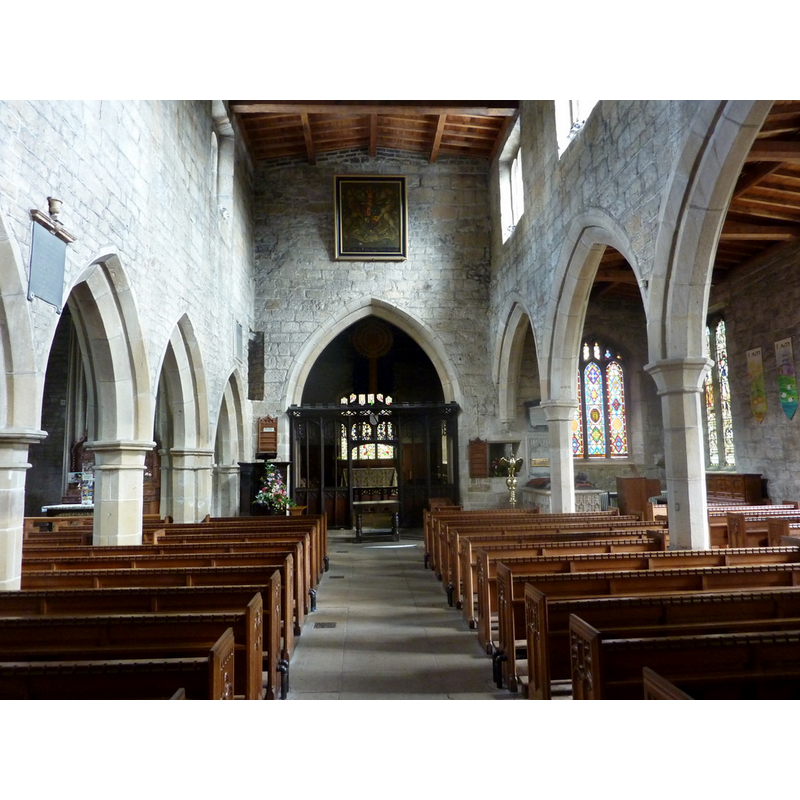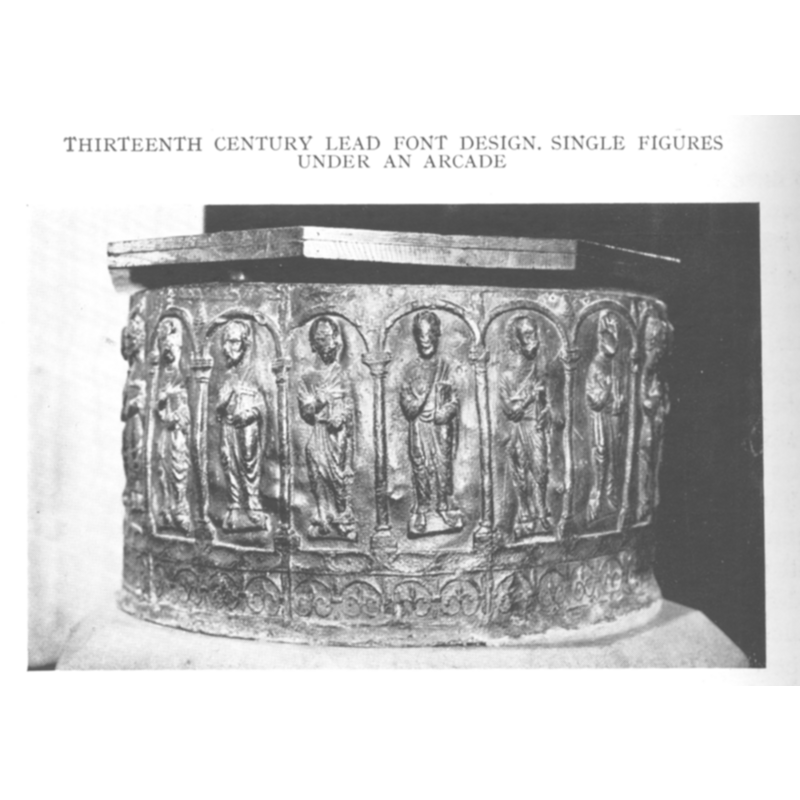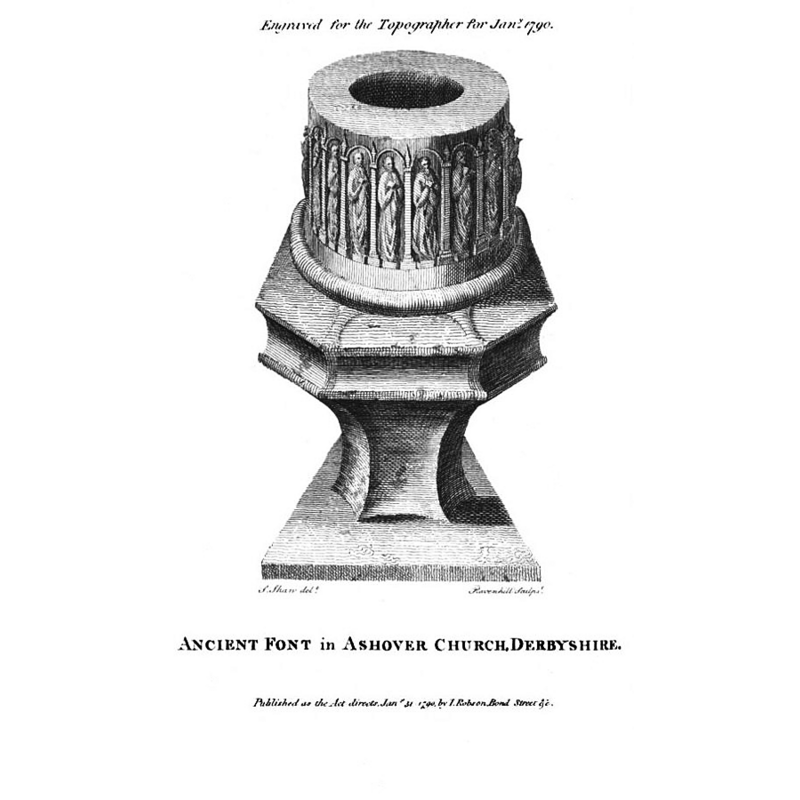Ashover / Essoure / Essovre
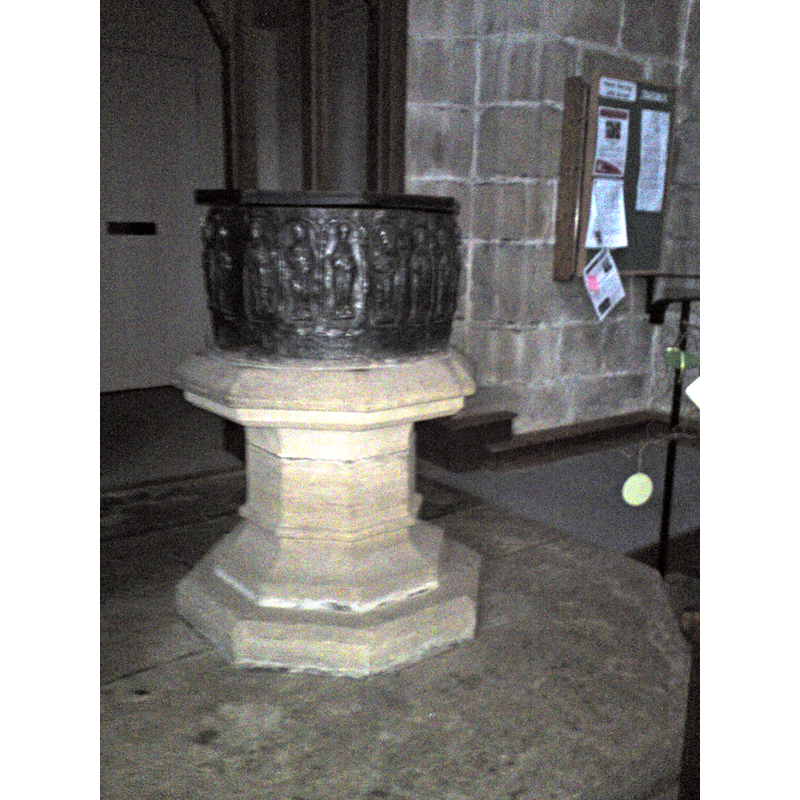
Image copyright © Phil Rose, 2009
Image and permission received via Colin Hinson (e-mail of 18 April 2010)
Results: 10 records
Apostle or saint - unidentified
design element - architectural - arcade - round arches - columns with capitals and bases
design element - motifs - floral
design element - motifs - floral or foliage
view of basin - interior
view of church exterior in context - southwest view
view of church interior - nave - looking east
view of font
view of font
Scene Description: notice the exagerated thickness of the the basin walls; also the base on which it was raised at the time
Copyright Statement: Image copyright © [in the public domain]
Image Source: engraving by Ravenhill (?) of a drawing by Shaw (?) in The Topographer, (1790)
Copyright Instructions: PD
INFORMATION
FontID: 00262ASH
Object Type: Baptismal Font1
Church/Chapel: Parish Church of All Saints
Church Patron Saints: All Saints
Church Location: Church Street, Ashover, Derbyshire, S45 0AB -- Tel.: +44 1246 590246
Country Name: England
Location: Derbyshire, East Midlands
Directions to Site: Located 8 km SSW of Chesterfield, 15 km SE of Bakewell
Ecclesiastic Region: Diocese of Derby
Historical Region: Hundred of Scarsdale [in Domesday]
Font Location in Church: Inside the church, at the W end of the N aisle
Date: ca. 1200? [Zarnecki]
Century and Period: 12th - 13th century, Late Norman
Workshop/Group/Artisan: lead font
Cognate Fonts: [cf. FontNotes below]
Credit and Acknowledgements: We are grateful to Colin S. Drake, Phil Rose and Timothy Marlow for their photographs of this font
Font Notes:
Click to view
There is an entry for Ashover [variant spelling] in the Domesday survey [http://domesdaymap.co.uk/place/SK3463/ashover/] [accessed 28 February 2015], and it mentions a priest and a church in it. A font here is noted and illustrated in The Topographer (issue no. X, January 1790: 61): "This font, of which an engraving is here given, is undoubtedly very ancient, and by some supposed to be Saxon. The base is of stone, and the embossed figures and ornamented niches, in which they stand, are lead." [NB: the accompanying engraving bears the names of "S. Shaw, del't" and "Ravenhill Sculps't", "Published as the Act directs, Jan. 31, 1790, by I. Robson, Bond St. &c."] Noted in Gough (1792) as a font decorated with the Apostles. There is another early description of this font in Lysons (1806-1833): "of lead, and apparently very ancient, being in the Saxon style: it is two feet one inch in width, and one foot in height; and is placed on a stone pedestal of more modern date. This font is ornamented with twenty figures of men, in flowing drapery, each holding a book in his left hand; and differing only in the position of the head, and of the right hand, which is more or less elevated in different figures". Described in Davies (1811): ''a very ancient font, supposed to be Saxon: the pedestal upon which it stands is of stone; the lower part is hexagonal, the upper part circular, an surrounded with twenty figures, in devotional attitudes, embossed in lead, which are cast in small compartments.'' Glover (1831) describes it as a lead font "in the Saxon style". Noted in Paley (1844), Batty (1848) and in Andre (1882). Described, with measurements, in Cox (1875), with references to Lysons, Gough, Simpson and Glover: "Cox (1875) notes a font of the Norman period at the west end of the north aisle and informs that it was "engraved in the second volume of the Topographer for the year 1790"; Cox (ibid.) describes the font: "The base is of stone in an hexagonal form, and is of a comparative modern date. The upper part, however, is circular and constructed of lead. It is two feet one inch in width, and about one foot in height. It is ornamented with twenty upright figures of men clad in flowing drapery. Each figure holds a book in his left hand, and stands under a semi-circular arch supported on slender pillars. These figures are almost precisely similar, and are rudely executed in bas-relief. Beneath them is a narrow border of fleurs-de-lis. The age of this font has been much over-rated by Lysons and Glover, who attribute it to the Saxon period. Lead fonts are very uncommon." [NB: Cox gives "a complete list of the leaden fonts to be found in England" in a footnote]. Lead baptismal font of the Late Norman period; there are twenty (?) [NB: only twelve according to Cox & Harvey (1907) and Bond (1908)] figures under round-headed arches on the lead casing of the stone bowl; underneath, a band of lillies. Noted in Lethaby (1893). Illustrated in Crossley (1941). Described and illustrated in Stone (1955) as one "of six identical fonts struck off the same mould"; Stone (Ibid.) finds parallel ornamentation with details of the Bury Saint Edmunds' Bible and the Winchester Bible. Described and illustrated in Zarnecki (1957): "The falling off in the quality of the fonts produced at the end of the Romanesque period is already visible here. The very fact that two figures were repeated ten times around the font shows a lack of inventiveness" [cf. supra regarding the differences]. By contrast, Jenkins (1999) describes it as a work of art "without equal in the county", and "one of only 30 left in England that avaited being melted for bullets at some stage of its life." Noted in Pevsner (1978): "Font. The most important Norman font in the county. Of lead, which is interesting as there was so much lead-mining all around [...]; of c. 1200, less good in quality than early C12 examples and very small, the bowl only about 2 ft across. It has standing figures of 8 in. under arcades, only two different figures, each repeated ten times and no doubt representing the Apostles. In design the font at Dorchester. Oxon, es especially similar." [We are grateful to Colin S. Drake for his photograph of this font]
COORDINATES
Church Latitude & Longitude Decimal: 53.164246, -1.480045
Church Latitude & Longitude DMS: 53° 9′ 51.29″ N, 1° 28′ 48.16″ W
UTM: 30U 601614 5891621
MEDIUM AND MEASUREMENTS
Material: Metal and stone, lead and stone (leaden encased stone)
Font Shape: cylindrical (mounted)
Basin Interior Shape: round
Basin Exterior Shape: round
Diameter (includes rim): 62.5 cm*
Basin Total Height: 30 cm*
Notes on Measurements: * in ft/in in Lysons (1806-1833, vol. I: p. 31); same measurements in Glover (1831) and Cox (1875)
LID INFORMATION
Date: modern
Material: wood
Apparatus: no
Notes: Simple wooden octagonal cover
REFERENCES
The History and gazetteer of the County of Derby: drawn up from actual observation and from the best authorities [...] the materials collected by the publisher Stephen Glover. Edited by Thomas Noble [...], Derby: Stephen Glover. Printed for the publisher by Henry Mozley and Son, 1831
André, J. Lewis, "Leaden Fonts in Sussex", 32, Surrey Archaeological Collections, relating to the history and antiquities of the county, 1882
Bagshaw, Samuel, History, gazetteer and directory of Derbyshire, with the town of Burton-upon-Trent […], Sheffield: printed for the author by William Saxton […], 1846
Batty, Robert Eaton, Some particulars connected with the history of baptismal fonts: being a paper read at the quarterly general meeting of the Architectural and Archaeological Society for the County of Buckingham, London: F. & J. Rivington, 1848
Bond, Francis, Fonts and Font Covers, London: Waterstone, 1985 c1908
Clapham, Alfred William, English Romanesque Architecture after the Conquest, Oxford: Clarendon Press, 1934
Clayton, Brian C., "English Church Fonts of Ornamental Lead Work", X, no. 57, Apollo: a Journal of the Arts, 1929, pp. 133-138; p. 133-138
Cox, John Charles J., English Church Fittings Furniture and Accessories, London: B.T. Batsford, 1922
Cox, John Charles, 1875-1877
Cox, John Charles, English Church Furniture, New York: E.P. Dutton & Co., 1907
Crossley, Frederick Herbert, English Church Craftsmanship: an Introduction to the Work of the Mediaval Period and Some Account of Later Developments, London: B.T. Batsford, 1941
Friar, Stephen, The Sutton Companion to Churches, Thrupp, Stroud (Gloucs.): Sutton Publishing, 2003
Gough, Richard, "Description of the old font in the Church of East Meon, Hampshire, 1789: with some observations on fonts", X, Archaeologia, 1792, pp. 183-209; p. 188 and fn
Jenkins, Simon, England's Thousand Best Churches, London and New York: Allen Lane, the Penguin Press, 1999 [2000 rev. printing]
Lethaby, William Richard, Leadwork, old and ornamental, and for the most part English [...] with illustrations, London; New York: Macmillan & co., 1893
Lysons, Daniel, Magna Britannia, being a concise topographical account of the several counties of Great Britain, London: Printed for T. Cadell and W. Davies, 1806-1822
Moule, Thomas, The English counties delineated; or, A topographical description of England [...], London: George Virtue, 1837 [vol. 2]
Paley, Frederick Apthorp, Illustrations of Baptismal Fonts, London, UK: John van Voorst, 1844
Pevsner, Nikolaus, Derbyshire, Harmondsworth: Penguin Books, 1978
Stone, Lawrence, Sculpture in Britain: the Middle Ages, Harmondsworth: Penguin Books, 1955
Zarnecki, George, English Romanesque Lead Sculpture: Lead Fonts of the Twelfth Century, London: A. Tiranti, 1957
![the number varies a/p source [cf. Font notes]](/static-50478a99ec6f36a15d6234548c59f63da52304e5/compressed/1020321003_compressed.png)
